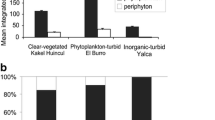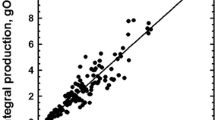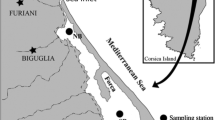Abstract
There have been few measurements of primary productivity by benthic (periphytic) and planktonic algae in prairie wetlands so their quantitative importance relative to other primary producers is largely unknown. We measured the daily productivity (inorganic carbon assimilation per m2 of wetland area) of phytoplankton, epipelon, epiphyton, and metaphyton in ten wetland cells in Delta Marsh, Manitoba over a five-year period. Water levels in the cells were manipulated so that some cells had normal water levels for the wetland, while water depths increased 30 cm or 60 cm in other treatments. With increasing water depth, phytoplankton productivity increased while that of epipelon, epiphyton, and metaphyton decreased. Metaphyton was the largest contributor to total algal productivity (70%), followed by epiphyton (23%), phytoplankton (6%), and epipelon (1%). Phytoplankton had the highest photosynthetic efficiency (C assimilated per unit chlorophyll), despite being a minor contributor to total productivity. Variations in P-I parameters (α, β, Ik, and Pmax) were considerable, possibly due to temporal and spatial fluctuation in the abiotic environment. Algal productivity was comparable to that of submersed and emergent macrophytes, suggesting that algae are probably important resources in supporting food webs in prairie wetlands.
Similar content being viewed by others
Literature Cited
Adams, M. S. and W. Stone. 1973. Field Studies on photosynthesis ofCladophora glomerata (Chlorophyta) in Green Bay, Lake Michigan. Ecology 54:853–862.
American Public Health Association (APHA). 1980. Standard Methods for the Examination of Water and Wastewater. 15th edition. Washington, DC, USA.
Auer, M. T., J. M. Graham, L. E. Graham, and J. A. Kranzfelder. 1983. Factors regulating spatial and temporal distribution ofCladophora andUlothrix in the Laurentian Great Lakes. p. 135–145.In R.G. Wetzel (ed.) Periphyton of Freshwater Ecosystems. Dr. W. Junk Publishers, The Hague, The Netherlands.
Batzer, D. P. and S. A. Wissinger. 1996. Ecology of insect communities in nontidal wetlands. Annual Review of Entomology 41: 75–100.
Brinton, M. M., A. E. Lugo, and S. Brown. 1981. Primary productivity, decomposition and consumer activity in freshwater wetlands. Annual Review of Ecology and Systematics 12:123–161.
Browder, J. A., P. J. Gleason, and D. R. Swift. 1994. Periphyton in the Everglades: spatial variation, environmental correlates, and ecological implications. p. 379–418.In S. M. Davis and J. C. Ogden (eds.) Everglades, The Ecosystem and Its Restoration. St. Lucie Press, Delray Beach, FL, USA.
Campeau, S., H. R. Murkin, and R. D. Titman. 1994. Relative importance of algac and emergent plant litter to freshwater marsh invertebrates. Canadian Journal of Fisheries and Aquatic Sciences 51:681–692.
Carper, G. L. and R. W. Bachmann. 1984. Wind resuspension of sediments in a prairie lake. Canadian Journal of Fisheries and Aquatic Sciences 41:1763–1767.
Cole, J. J. and S. G. Fisher. 1977. Annual metabolism of a temporary pond ecosystem. The American Midland Naturalist 100: 15–22.
Cronk, J. K. and W. J. Mitsch. 1994. Periphyton productivity on artificial and natural surfaces in constructed freshwater wetlands under different hydrologic regimes. Aquatic Botany 48:325–341.
Eaton, J. W. and B. Moss. 1966. The estimation of numbers of pigment content in epipelic algal populations. Limnology and Oceanography 11:584–595.
Eiseltová, M. and J. Pokorný. 1994. Filamentous algae in fish ponds of the Trebon Biosphere Reserve—ecophysiological study. Vegetatio 113:155–170.
Fee, E. J. 1973. Modeling primary production in water bodies: a numerical approach that allows vertical inhomogeneities. Journal of the Fisheries Research Board of Canada 30:1469–1473.
Fee, E. J., R. E. Hecky, and H. A. Welch. 1987. Phytoplankton photosynthesis parameters in central Canadian lakes. Journal of Plankton Research 9:305–316.
Geider, R. J. and B. A. Osborne. 1992. Algal Photosynthesis. The Measurement of Algal Gas Exchange. Chapman and Hall, New York, NY, USA.
Goldsborough, L. G. and G. G. C. Robinson. 1996. Pattern in wetlands. p. 77–117.In R. J. Stevenson, M. L. Bothwell, and R. L. Lowe (eds.) Algal Ecology: Benthic Freshwater Ecosystems. Academic Press, New York, NY, USA.
Goldsborough, L. G., G. G. C. Robinson, and S. E. Gurney. 1986. An enclosure/substratum system forin situ ecological studies of periphyton. Archiv für Hydrobiologie 106:373–393.
Gurney, S. E. and G. G. C. Robinson. 1988. The influence of water level manipulation on metaphyton production in a temperate freshwater marsh. Verhandlungen Internationale Vereinigung für Theoretische und Angewandte Limnologie 23:1032–1040.
Hooper, N. M. and G. G. C. Robinson. 1976. Primary production of epiphytic algae in a marsh pond. Canadian Journal of Botany 54:2810–2815.
Hosseini, S. M. 1986. The effects of water level fluctuation on algal communities of freshwater marshes. Ph.D. Dissertation. Iowa State University, Ames, IA, USA.
Hutchinson, G. E. 1975. A Treatise on Limnology, Volume 1. Part 1: Geography and Physics of Lakes. John Wiley and Sons, New York, NY, USA.
Jones, R. C. 1984. Application of a primary production model to epiphytic algae in a shallow, eutrophic lake. Ecology 65:1895–1903.
Keough, J. R., M. E. Sierszen, and C. A. Hagley. 1996. Analysis of a Lake Superior coastal food web with stable isotope techniques. Limnology and Oceanography 41:136–146.
Kotak, B. G. 1990. The effects of water turbulence on the limnology of a shallow, prairie wetland. M.Sc. Thesis, University of Manitoba, Winnipeg, MB, Canada.
Kotak, B. G. and G. G. C. Robinson. 1991. Artificially-induced water turbulence and the physical and biological features within small enclosures. Archiv für Hydrobiologie 122:335–349.
Losee, R. F. and R. G. Wetzel. 1983. Selective light attenuation by the periphyton complex. p. 89–96.In R. G. Wetzel (ed.) Periphyton of Freshwater Ecosystems. Dr W. Junk Publishers, The Hague, The Netherlands.
Marker, A. F. H., C. A. Crowther, and R. J. M. Gunn. 1980. Methanol and acetone for estimating chlorophyll a and phaeopigments by spectrophotometry. Archiv für Hydrobiologie Beihefte 14:52–69.
Murkin, H. R. 1989. The basis for food chains in prairie wetlands. p. 316–338.In A. van der Valk (ed.) Northern Prairie Wetlands. Iowa State University Press, Ames, IA, USA.
Murkin, H. R., B. D. J. Batt, P. J. Caldwell, C. B. Davis, J. A. Kadlec, and A. G. van der Valk. 1984. Perspectives on the Delta Waterfowl Research Station—Ducks Unlimited Canada Marsh Ecology Research Program. Transactions of the North American Wildlife and Nature Research Conference 49:253–261.
Pasciak, W. J. and J. Gavis. 1974. Transport limitation of nutrient uptake in phytoplankton. Limnology and Oceanography 19:881–888.
Pinckney, J. and R. G. Zingmark. 1993. Photophysiological responses of intertidal benthic microalgal communities to in situ light environments: methodological considerations. Limnology and Oceanography 38:1373–1383.
Platt, T., C. L. Gallegos, and W. G. Harrison. 1980. Photoinhibition of photosynthesis in natural assemblages of marine phytoplankton. Journal of Marine Research 38:687–701.
Prezelin, B. B. and A. C. Ley. 1980. Photosynthesis and chlorophyll-a fluorescence rhythms of marine phytoplankton. Marine Biology 55:295–307.
Reeder, B. C. and W. J. Mitsch. 1989. Seasonal patterns of planktonic and macrophyte productivity of a freshwater coastal wetland. p. 49–68.In W. J. Mitsch (ed.) Wetlands of Ohio’s coastal Lake Erie: a hierarchy of systems. Ohio Sea Grant publication, Columbus, OH, USA.
Reynolds, C. S. 1984. The Ecology of Freshwater Phytoplankton. Cambridge, London, UK.
Richmond, K. A. 1992. A comparison of photosynthesis of metaphyton in eutrophic littoral waters with that of an acidified lake. B.Sc. Thesis, University of Manitoba, Winnipeg, MB, Canada.
Robarts, R. D., D. B. Donald, and M. T. Arts. 1995. Phytoplankton primary production of three temporary northern prairie wetlands. Canadian Journal of Fisheries and Aquatic Sciences 52:897–902.
Robinson, G. G. C. 1988. Productivity-irradiance relationships of the algal communities in the Delta Marsh: a preliminary report. University Field Station (Delta Marsh) Annual Report 23:100–110.
Robinson, G. G. C., S. E. Gurney, and L. G. Goldsborough. 1997. Response of benthic and planktonic algal biomass to experimental water level manipulation in a prairie wetland. Wetlands 17:167–181.
Roos, P. J. and J. T. Meulemans. 1987. Under water light regime in a reedstand—short-term, daily, and seasonal. Archiv für Hydrobiologie 111:161–169.
Savidge, G. 1988. Influences of inter- and intra-daily light-field variability on photosynthesis by coastal phytoplankton. Marine Biology 100:127–133.
Schalles, J. F. and D. J. Shure. 1989. Hydrology, community structure, and productivity patterns of a dystrophic Carolina Bay wetland. Ecological Monographs 59:365–385.
Shay, J. M. and C. T. Shay. 1986. Prairie marshes in western Canada, with specific reference to the ecology of five emergent macrophytes. Canadian Journal of Botany 64:443–454.
Simpson, P. S. and J. W. Eaton. 1986. Comparative studies of the submerged macrophyteElodea canadensis and filamentous green algaeCladophora glomerata andSpirogyra sp. Aquatic Botany 24:1–12.
Stanley, D. W. 1976. Productivity of epipelic algae in tundra ponds and a lake near Barrow, Alaska. Ecology 57:1015–1024.
Strickland, J. D. H. and T. R. Parsons. 1972. A Practical Handbook of Seawater Analysis, 2nd edition. Fisheries Research Board of Canada Bulletin 167, Ottawa, ON, Canada.
Sullivan, M. J. and C. A. Moncreiff. 1988. Primary production of edaphic algal communities in a Mississippi salt marsh. Journal of Phycology 24:49–58.
Tilzer, M. M., M. Elbrachter, W. W. Gleskes, and B. Beese. 1986. Light-temperature interactions in the control of photosynthesis in Antarctic phytoplankton. Polar Biology 5:105–111.
Turner, M. A., G. G. C. Robinson, B. E. Townsend, B. J. Hann, and J. A. Amaral. 1995. Ecological effects of blooms of filamentous green algae in the littoral zone of an acid lake. Canadian Journal of Fisheries and Aquatic Science 52:2264–2275.
van der Valk, A. G. 1994. Effects of prolonged flooding on the distribution and biomass of emergent species along a freshwater wetland coenocline. Vegetatio 110:185–196.
van der Valk, A. G. and C. B. Davis. 1978. The role of seed banks in the vegetation dynamics of prairie glacial marshes. Ecology 59: 322–335.
Vymazal, J. 1994. Algae and Element Cycling in Wetlands. Lewis Publishers, Boca Raton, FL, USA.
Wetzel, R. G. and G. E. Likens. 1991. Limnological Analyses, 2nd edition. Springer-Verlag, New York, NY, USA.
Williams, N. J. 1978. Annual variation of photosynthetic parameters in Lake Tahoe. Verhandlungen Internationale Vereinigung für Theoretische und Angewandte Limnologie 20:419–425.
Wood, K. G. 1975. Photosynthesis ofCladophora in relation to light and CO2 limitation; CaCO3 precipitation. Ecology 56:479–484.
Author information
Authors and Affiliations
Corresponding author
Rights and permissions
About this article
Cite this article
Robinson, G.G.C., Gurney, S.E. & Gordon Goldsborough, L. The primary productivity of benthic and planktonic algae in a prairie wetland under controlled water-level regimes. Wetlands 17, 182–194 (1997). https://doi.org/10.1007/BF03161408
Received:
Revised:
Accepted:
Issue Date:
DOI: https://doi.org/10.1007/BF03161408




